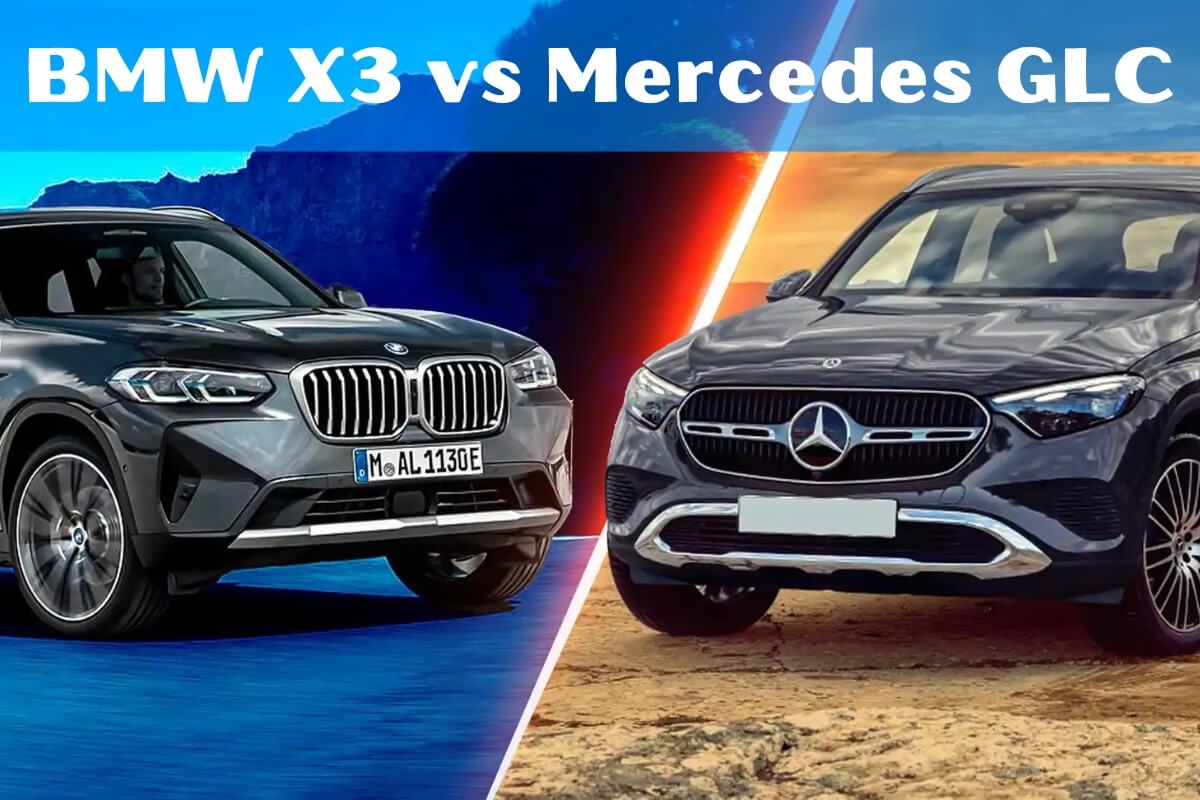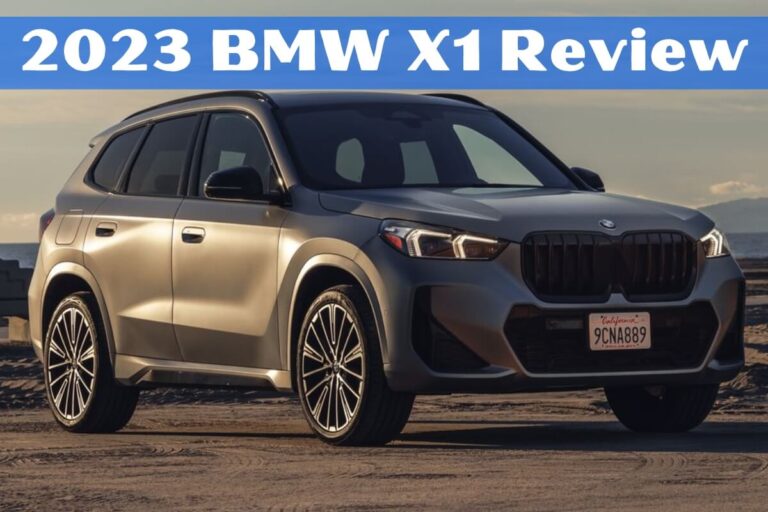BMW X3 vs Mercedes GLC: Clash of Luxury SUV Titans

The luxury compact SUV segment is one of the hottest automotive markets right now. Two of the most popular models battling for supremacy are the BMW X3 and Mercedes-Benz GLC. In this detailed comparison, we’ll dive into all aspects of these vehicles to help you decide which one is the better choice for your needs.
The key questions we’ll explore include:
- Which SUV has a more stylish and attractive exterior design?
- How do their interiors compare in terms of premium feel, technology, and space?
- What powertrains and performance capabilities do they offer?
- Which one delivers a more comfortable and engaging driving experience?
- How fuel-efficient are the various engine options?
- What safety ratings and driver assistance features are available?
- Which model provides better value considering pricing and cost of ownership?
So buckle up as we put the BMW X3 and Mercedes GLC head-to-head across all the factors that matter most to luxury SUV buyers. By the end, you’ll know which German rival deserves the edge.
Exterior Design: Blending Sophistication and Sportiness
When it comes to exterior styling, both the X3 and GLC aim to blend sophisticated luxury cues with a sporty, athletic stance. However, they go about achieving this in slightly different ways.
The BMW X3 features the brand’s signature kidney grille flanked by sleek LED headlights. Its profile is defined by taut character lines and sculpted surfaces that convey an elegant yet muscular look. The X3’s rear end keeps things simple with LED taillights and dual exhaust tips.
In contrast, the Mercedes-Benz GLC takes a bolder approach with its more upright front grille accented by jewel-like LED headlamps. Distinct sculpting along the sides and flared wheel arches lend an aggressive flair. At the back, the GLC’s taillights are elegantly integrated into the rear quarter panels.
Both offer stylish alloy wheel designs, with sizes ranging from 18 to 21 inches depending on the trim level selected. The BMW is a tad larger overall, but the size differential is marginal.
On the whole, the GLC’s more imposing road presence and attention-grabbing details give it a slight edge for those who prioritize head-turning curb appeal. But the X3 counters with a more understated yet classy aura that many luxury buyers will also appreciate.
Stepping Inside the Luxury Cabins
Much like their exteriors, the BMW X3 and Mercedes GLC take divergent approaches to interior design and execution.
The X3’s cabin centers around the driver with a cockpit-like layout for the controls and displays. Material quality is exceptionally high, with ample soft-touch surfaces and elegant accents. The standard infotainment system utilizes BMW’s iDrive interface with a 10.3-inch touchscreen, though a larger 12.3-inch unit is available.
Front and rear occupants will enjoy plenty of room to stretch out, and the 28.7 cu-ft cargo area is among the largest in the class. Folding the rear seats expands it to an even more capacious 62.7 cu-ft.
The Mercedes GLC’s interior exudes a more elegant, avant-garde vibe with its sweeping shapes and curved surfaces. Intricate air vents and ambient lighting touches add serious wow factor. Twin 12.3-inch displays for the instrument cluster and infotainment system come standard, controlled by Mercedes’ slick MBUX interface.
While passenger space is comparable to the X3, the GLC falls behind a bit in cargo capacity with 21.1 cu-ft behind the rear seats. That said, it remains a spacious and well-appointed cabin overall.
Both interiors are certainly befitting of their luxury status, but the GLC’s cabin takes things to a higher level with its artistic flair and more advanced technologies right from the get-go.
Potent Powertrains for Performance Driving
Buyers can choose from a range of turbocharged gasoline and hybrid powertrains with the X3 and GLC, including some serious performance variants for driving enthusiasts.
The BMW X3 offers four different engines:
- sDrive30i/xDrive30i: turbocharged 2.0L 4-cylinder with 248 hp and 258 lb-ft of torque
- M40i: turbocharged 3.0L inline-6 with 382 hp and 369 lb-ft (0-60 mph in 4.4 sec)
- X3 M: twin-turbo 3.0L inline-6 with 473 hp and 457 lb-ft (0-60 in 3.9 sec)
- X3 M Competition: upgraded twin-turbo 3.0L with 503 hp and 479 lb-ft (0-60 in 3.7 sec)
On the Mercedes side, the 2023 GLC lineup consists of:
- GLC 300 4MATIC: turbocharged 2.0L inline-4 with 258 hp and 295 lb-ft
- AMG GLC 43: Turbo 2.0L inline-4 with 402 hp and 369 lb-ft (0-60 in 4.7 sec)
- AMG GLC 63 S: Twin-turbo 4.0L V8 with 469 hp and 479 lb-ft (3.6 sec 0-60)
The range-topping AMG models showcase immensely potent performance. But even the base turbo fours provide plenty of gusto for daily driving while returning decent fuel economy.
Most X3 and GLC models utilize an 8-speed automatic transmission, though Mercedes tends to favor a smoother 9-speed unit. Both offer rear-wheel-drive (sDrive or RWD) or all-wheel-drive (xDrive or 4MATIC) configurations.
How Do They Drive? Balancing Comfort and Agility
When it comes to the luxury SUV driving experience, both the BMW X3 and Mercedes GLC place an emphasis on a compelling blend of comfort and agility.
The X3 lives up to BMW’s “Ultimate Driving Machine” ethos with beautifully weighted steering and excellent body control. The trade-off is a ride that borders on firm, especially with larger wheels or the M Sport suspension. Road and wind noise are also more pronounced.
In typical Mercedes fashion, the GLC leans slightly more towards the comfort side of the equation with a plush, well-damped ride quality. The steering is light but precise, and handling remains reasonably crisp when driven spiritedly.
Both offer selectable drive modes that allow tailoring the driving experience from Eco to Sport+. The Mercedes AIRMATIC suspension, an affordable option, helps split the difference with excellent damping across different scenarios.
For those seeking enhanced off-road prowess, the X3 can be had with an Off-Road Package with extra ground clearance, while the GLC offers an available Air Body Control system.
Overall, enthusiast drivers who don’t mind a taut ride will likely prefer the X3’s sporty dynamics. But the GLC hits a sweet spot for buyers who want a sublime ride partnered with very capable handling and response.
Real-World Efficiency: Sipping or Guzzling?
Fuel efficiency may not be top of mind for luxury SUV buyers, but it’s still a relevant factor for budgeting running costs. So how do these German rivals stack up at the pumps?
For the mainstream gasoline models, the rear-drive BMW X3 sDrive30i is EPA-rated at 23 mpg city and 29 mpg highway. Adding xDrive all-wheel-drive drops those figures slightly to 21/28 mpg.
The Mercedes-Benz GLC 300 4MATIC counters with superior ratings of 24 mpg city and 33 mpg highway thanks to its mild-hybrid assist system. That could translate into over $300 in annual fuel savings versus the X3.
Moving up to the performance variants, the X3 M40i returns 21/26 mpg. The Mercedes AMG GLC 43 fares worse at just 19/26 mpg despite its smaller displacement turbo-four engine.
If maximum efficiency is the goal, BMW now offers a plug-in hybrid X3 xDrive30e rated at 49 MPGe combined when operating on electric power. Its 17.7-kWh battery provides an estimated 18-19 miles of all-electric range.
Top speed merchants will pay dearly at the pump with the hardcore performance models like the BMW X3 M Competition (16 mpg city / 23 highway) and Mercedes-AMG GLC 63 S (15/22 mpg). Their blistering acceleration comes at the cost of heavy fuel consumption.
While neither the X3 nor GLC will win any hypermiling awards, the plug-in hybrid and mild-hybrid options demonstrate that efficiency is possible without sacrificing too much performance or luxury. For eco-conscious buyers, the GLC300’s superior EPA ratings give Mercedes a clear advantage here.
Prioritizing Safety and Driver Aids
When it comes to safeguarding occupants, both the BMW X3 and Mercedes-Benz GLC have earned top safety ratings from NHTSA and IIHS. They also come standard with a robust suite of active driver assistance technologies:
- Automatic emergency braking
- Blind spot monitoring
- Rear cross-traffic alert
- Lane keeping assist
- Automatic high-beam headlights
Available safety upgrades allow enhancing their capabilities even further with features like:
- Adaptive cruise control
- Lane change assist
- Surround-view camera system
- Head-up display
- Hands-free parking assist
These optional packages do increase the bottom line, but many buyers deem the added peace of mind worthwhile – especially those who frequently drive in heavy traffic or with a full load of passengers.
While their core safety credentials are evenly matched, the GLC pulls slightly ahead in this category courtesy of Mercedes’ more cutting-edge innovations in semi-autonomous driving aids. Its DRIVE PILOT system allows for limited hands-free operation under certain conditions.
Breaking Down Value and Pricing
When weighing the BMW X3 against the Mercedes-Benz GLC, pricing becomes an increasingly significant factor as you move up in trim levels and add options.
For the 2023 model year, the X3 sDrive30i kicks things off with a Manufacturer’s Suggested Retail Price (MSRP) of $46,900 including destination fees. The all-wheel-drive xDrive30i starts just under $50k.
In contrast, the GLC 300 4MATIC carries a slightly higher base MSRP of $49,200. But it comes better equipped out of the box.
As you start piling on options like premium audio, heated/ventilated seats, panoramic moonroofs and driver assistance packages, the two become more evenly matched in the $55,000 to $65,000 range for a well-appointed example.
Performance models are where the luxury tax gets steep. The X3 M40i starts at $62,500, while a loaded X3 M Competition can crest $90,000. For the GLC, the AMG GLC 43 costs $68,200, and the fire-breathing AMG GLC 63 S runs a cool $96,800.
BMW does hold one potential ownership advantage in the form of its no-cost 3-year/36,000-mile complimentary scheduled maintenance. That perk isn’t included for the GLC.
When factoring in their pricing and the overall luxury experience delivered, both the X3 and GLC represent great values – but the BMW maintains a slight edge in that arena for more budget-conscious shoppers.
The Verdict: Which Luxury SUV Reigns Supreme?
After an exhaustive evaluation of their attributes, the BMW X3 and Mercedes-Benz GLC emerge as two very impressive yet different takes on the luxury compact SUV formula.
The X3 upholds BMW’s sporting character and driver engagement with its tenacious handling, potent powertrain options and impeccably crafted interior accommodations. It’s the enthusiast’s choice for those prioritizing athletic driving dynamics.
Meanwhile, the GLC counters with an elegant, state-of-the-art cabin and smoother ride composure more befitting of the Mercedes luxury touring car experience. Its bold, eye-catching sheetmetal and tech innovations also can’t be overlooked.
When it comes to value, the X3’s lower starting prices provide an advantage at the lower trim levels. But the GLC’s generous level of standard equipment helps offset that factor.
Ultimately, both are immensely compelling options that satisfy the demands of compact luxury SUV buyers. Those who place a premium on dynamic driving thrills will gravitate toward the BMW X3. But the Mercedes-Benz GLC’s more well-rounded total package – pairing exemplary refinement with energetic performance – makes it our overall pick for most buyers.
Of course, there are many other worthy alternatives in this red-hot segment too, including models like the Genesis GV70, Volvo XC60, Lexus NX and more. Smart shoppers should expand their search and test drives to find the perfect fit.
No matter which direction your search leads, the SUV luxury battle between BMW and Mercedes-Benz exemplifies just how rewarding the options have become for discerning buyers.






